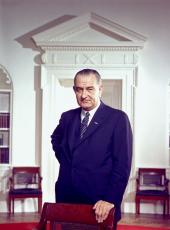By the President of the United States of America
A Proclamation
The Langley Research Center this year marks its fiftieth year as a national resource. Established in 1917, it was the first national laboratory to conduct basic research in the science of aeronautics.
During the last fifty years the speed of airplanes has increased from less than 100 miles an hour to more than 4,000 miles an hour, and the exciting epoch of the exploration of space has begun.
Langley's contributions have been many. Among them are:
—The development in the late Twenties of the cowling for radial air-cooled engines, a streamlining effect that boosted airplane speeds 12 to 15 percent.
—The scientific information and technical skills needed to increase the performance and utility of World War II aircraft.
—The research facilities that made possible the advancement of supersonic and hypersonic aircraft.
—The investigations into concepts of advanced supersonic and hypersonic vehicles, helicopters, and vertical and short takeoff and landing aircraft.
The passive communications satellite Echo owes much to Langley research, as does the Explorer series of spacecraft that has taught us so much about the space environment in which we live.
Research at Langley contributed to the development of the versatile Scout vehicle, first of the all-solid-fueled rockets, as well as to the management of Lunar Orbiter and other such major flight efforts as Project Fire.
Langley was the birthplace of Project Mercury, the first United States manned space flight project. Important research was continued there in support of our continuing manned flight efforts, Gemini and Apollo.
The Center is supporting Project Apollo through the use of simulators and specialized laboratories. Through those facilities, we are able to simulate on earth some of the conditions of space and to develop techniques for such events as lunar landing, walking on the moon, extravehicular activities, rendezvous and docking in lunar orbit, reentry, and earthlanding.
In recognition of the Langley Research Center's contribution to the advancement of the United States in aeronautics and astronautics, the Congress, by a joint resolution approved October 3, 1967, has requested the President to issue a proclamation commemorating the fiftieth anniversary of the establishment of the Langley Research Center.
Now, Therefore, I, Lyndon B. Johnson, President of the United States of America, call upon the Administrator of the National Aeronautics and Space Administration and the people of the United States to join, during the week of October 1 through October 7, 1967, in commemorating the fiftieth anniversary of the establishment of the Langley Research Center at Hampton, Virginia, with appropriate ceremonies and activities.
In Witness Whereof, I have hereunto set my hand this third day of October, in the year of our Lord nineteen hundred and sixty-seven, and of the Independence of the United States of America the one hundred and ninety-second.

LYNDON B. JOHNSON
Lyndon B. Johnson, Proclamation 3811—Fiftieth Anniversary of the Langley Research Center Online by Gerhard Peters and John T. Woolley, The American Presidency Project https://www.presidency.ucsb.edu/node/306224

